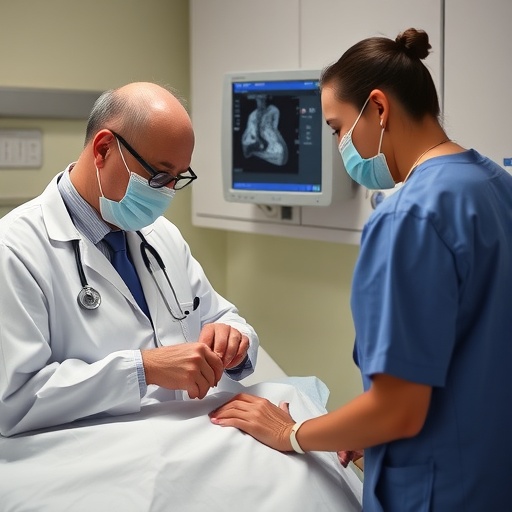In a groundbreaking clinical investigation conducted at Rutgers Robert Wood Johnson Medical School (RWJMS) in collaboration with RWJBarnabas Health, a transformative shift in diagnosing hospitalized patients experiencing shortness of breath has been demonstrated. Traditionally reliant on the stethoscope, clinicians are now urged to consider portable point-of-care ultrasound devices as a superior diagnostic tool, according to findings recently published in JAMA Network Open. This experimental study investigated the impact of integrating portable cardiopulmonary ultrasonography into frontline hospital care, revealing significant improvements in diagnostic accuracy, patient outcomes, and healthcare economics.
The crux of the study rested on deploying compact, smartphone-attached ultrasound units to perform rapid cardiopulmonary assessments. These devices, weighing a fraction of standard ultrasound machines, provide real-time, high-resolution imaging of heart and lung structures. Unlike traditional auscultation, which depends heavily on the clinician’s auditory interpretation of breath and heart sounds, ultrasonography offers a direct, visual appraisal of the internal physiology. This distinction is critical in the context of undifferentiated dyspnea—a clinical presentation that can herald a spectrum of pathologies such as pulmonary edema, heart failure, or chronic obstructive pulmonary disease exacerbations.
The study enrolled 208 patients admitted to Robert Wood Johnson University Hospital with complaints of shortness of breath. Patients were randomized to receive initial diagnostic evaluation either through conventional methods or through point-of-care ultrasound. Remarkably, those assessed via ultrasound demonstrated an average hospital stay reduction from 11.9 days down to 8.3 days. This shortened length of stay translated into a cumulative savings of 246 bed-days and approximately $751,000 in direct hospital costs, underscoring the tangible economic benefits of introducing bedside sonographic evaluation.
The clinical superiority of ultrasound arises from its ability to visualize fluid accumulation, cardiac contractility, and pulmonary conditions in real time. The portable ultrasound protocol utilized in this study focused on a concise set of cardiac views along with a six-zone lung examination. This streamlined approach was designed to be efficient and binary, allowing clinicians to rapidly identify the presence or absence of congestion and systolic dysfunction. By concentrating on these key parameters, the exam could be completed within 10 to 15 minutes, a timeframe conducive to integration within busy hospital rounds.
A critical aspect of the study involved training hospitalists who traditionally rely on auscultation and other physical exam techniques. Participants received several hours of hands-on ultrasound instruction, enabling them to perform and interpret the protocol with reasonable proficiency. However, despite the training, hospitalists were often constrained by time pressures and workflow demands, leading many to delegate the sonographic examination to specialized sonographers and rely on cardiologists for image interpretation. Only around 20% of the ultrasound assessments were directly conducted and interpreted by the hospitalists themselves.
Senior study author Dr. Partho Sengupta emphasized the challenge: although the ultrasound probe is compact and smartphone-compatible, its consistent adoption within clinical practice has been limited. This reality reflects not a shortfall of the technology but systemic barriers including time constraints, entrenched clinical routines, and the absence of strong incentives for procedural adoption. Nevertheless, the successful implementation of a multidisciplinary framework in this study—encompassing hospitalists, sonographers, cardiologists, engineers, and data scientists—demonstrated a viable pathway to overcoming these obstacles.
One of the study’s most striking findings was that ultrasound information altered medical management in about one-third of cases. This included new diagnoses and significant shifts in treatment plans, highlighting the modality’s ability to refine clinical decision-making. Patients with more complex, prolonged hospitalizations appeared to benefit disproportionately, suggesting that ultrasound-guided triage could optimize resource utilization and improve outcomes in the highest-risk populations.
The research team, led by experts including cardiology professors Kameswari Maganti and hospitalists Catherine Chen and Payal Parikh, collaborated closely with sonographers and the engineering team headed by Naveena Yanamala. This integrated approach ensured accurate image acquisition, reliable interpretation, and seamless data integration to support clinical decision-making. This model provides a template for other institutions aiming to incorporate ultrasonography into routine hospital care pathways.
Despite its promise, the study acknowledges limitations inherent to its single-center design, and the reliance on trained sonographers and cardiologists for image interpretation may limit generalizability. Further multi-center trials are essential to validate these findings across diverse healthcare settings. Additionally, strategies to embed ultrasound use into daily hospitalist workflows and incentives aligned with improved patient care and cost reduction will be critical to broader adoption.
Technologically, portable ultrasound systems continue to advance, incorporating artificial intelligence and enhanced image processing to augment clinician accuracy and reduce interpretation variability. As these innovations mature, the integration of point-of-care ultrasonography is poised to revolutionize hospital medicine by enabling early, precise diagnosis, minimizing unnecessary testing, and accelerating tailored therapies for cardiopulmonary conditions.
In conclusion, this study redefines the diagnostic paradigm for hospitalized patients with respiratory distress. By leveraging the direct visualization capabilities of portable ultrasound devices, clinicians can transcend the limitations of traditional stethoscope-based examination. This approach not only yields superior diagnostic clarity but also delivers palpable clinical and economic benefits, ultimately fostering more efficient, patient-centered hospital care.
Subject of Research: People
Article Title: Cardiopulmonary Point-of-Care Ultrasonography for Hospitalist Management of Undifferentiated Dyspnea
News Publication Date: 5-Sep-2025
Web References: DOI link
Image Credits: Rutgers Health/RWJBarnabas Health
Keywords: Ultrasound, Medical diagnosis
Tags: cardiopulmonary ultrasonography in hospitalsclinical investigation on ultrasounddiagnosing shortness of breatheconomic impact of ultrasound in healthcareenhancing diagnostic accuracy in dyspneaimproving patient outcomes with ultrasoundinnovative healthcare solutions for respiratory distressportable point-of-care ultrasound benefitsrapid cardiopulmonary assessment technologyRutgers RWJBarnabas Health studysmartphone-attached ultrasound devicestraditional stethoscope limitations





